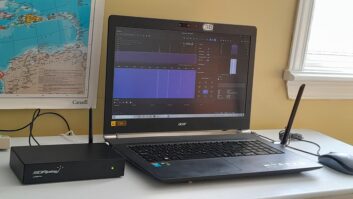(click thumbnail)Fig. 1Now that summer is in full swing, consider adding a safety “insurance” tray designed by Jon Banks, a contract engineer in Colorado.
Space limitations require the air-conditioning system to be ceiling-mounted. Although they weren’t directly over the transmitters, Jon didn’t want to take any chances with clogged condensate drains.
(click thumbnail)Fig. 1
Fig. 1 shows the tray mounted under the air conditioner. Note how the tray has a drainpipe tied to the condensate drain, just in case a flood occurs. A moisture sensor placed in the pan and tied to the remote control is a fitting final touch.
Fig. 2 is a close-up of the condensate drain, which should always include a trap and a capped port for cleaning.
Speaking of cleaning, now is the time to place an anti-algae tablet in the drain pan of your air conditioner. These horse-pill sized tablets prevent the formation of algae in the drain system. Algae, which the summer heat only accelerates, develops a formidable clog that will block the drain and cause indoor flooding. The tablets are available at HVAC supply stores.


. . .
Grounding, or the lack thereof, can do some weird things.
Mike Patton, president of Michael Patton and Associates in Baton Rouge, Fla., recalls an RF problem in which an MW-1 transmitter couldn’t be turned up above 200 watts because the higher power would literally kill the audio.
All suspicions were on the transmitter; but when Mike arrived, he found a 40V peak-to-peak RF difference (measured on a scope) between the transmitter chassis and the rack next to it. Both the transmitter and the rack were tied to ground straps – different ground straps.
Further analysis showed the RF appeared on the output terminals of the audio processor, wiping out the op-amp outputs by being forced back into them. Mike writes on Dave Biondi’s [email protected] that this is a common occurence, RF getting back into the outputs, and one that often is overlooked.
The problem was resolved by grounding the rack and transmitter together.
In troubleshooting radio frequency interference, shielding is the next thing to check. Conventional wisdom is to ground the audio shields as only one end; otherwise the shield carries current if there is any voltage difference between the two ends. If such a situation occurs, the shield stops shielding and contributes to the problem by inducing current into the wires inside.
It’s generally considered best to ground the shield at the lowest-impedance end, which is almost always the source. In building more than 100 studios, Mike says he’s not seen connecting either end an issue – as long as there’s no RF. Just make sure both ends don’t get grounded.
Add RF, and the rules all change. Sometimes grounding at both ends works best, sometimes only one end. And which end may make a difference.
It’s been Mike’s experience that if you need to ground both ends of a wire to improve the situation, you might want to engineer a better ground connection between the two points, then revisit the issue of grounding the shield.
A last resort is to use chokes and bypass capacitors. Remember that while caps are easier to obtain and install, chokes are much more effective. Capacitors only shunt RF away by providing a low-impedance path (you hope) to ground. The RF current is still there, but redirected.
Chokes, on the other hand, are high impedance at RF frequencies, so they actually stop the flow of RF current, which causes less-desirable side effects. Chokes can be added to either the source or the termination end of an audio or remote control metering pair, or both, depending on where the interference is occurring.
Generally speaking, the end where the shield is connected will have the lower RF voltage, although even relatively low levels of RF can cause trouble with certain circuits. Don’t be afraid to try a choke at any I/O point.
They can be purchased for less than $1 with values from 500 to 1,000 uHy from Mouser, Digi-Key and others.
Submissions for this column are encouraged, and qualify for SBE recertification credit. Fax your submission to (703) 323-8044, or send e-mail to [email protected]







